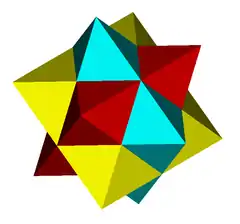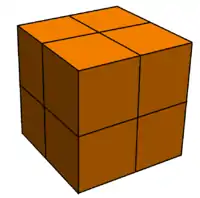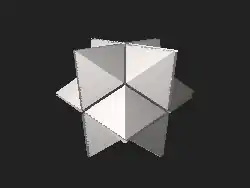Yoshimoto Cube
The Yoshimoto Cube is a polyhedral mechanical puzzle toy invented[1] in 1971 by Naoki Yoshimoto (吉本直貴, Yoshimoto Naoki), who discovered that two stellated rhombic dodecahedra could be pieced together into a cube when he was finding different ways he could split a cube equally in half. Yoshimoto first introduced his cube in 1972 at a solo exhibition entitled "From Cube to Space", and later developed three commercial versions. In 1982, Yoshimoto Cube No. 1 was included in the Museum of Modern Art's permanent collection.[2]
| Type | Dissection puzzle |
|---|---|
| Company | Museum of Modern Art |
| Availability | 1971–present |
The cube is made up of eight interconnected cubes which can be folded or unfolded indefinitely. The unfolded cube can be dissected and reassembled into two stellated rhombic dodecahedra, each of which comprise half the volume of the original cube, making it a kind of three-dimensional dissection puzzle.

 2×2×2 cube form of Yoshimoto Cube
2×2×2 cube form of Yoshimoto Cube STL model of the first stellation of the rhombic dodecahedron decomposed into pyramids and half-cubes
STL model of the first stellation of the rhombic dodecahedron decomposed into pyramids and half-cubes
References
- "Naoki Yoshimoto". The Moleskine Project. Retrieved 20 August 2018.
- "Yoshimoto Cube No. 1 | MoMA Design Store". Museum of Modern Art Store. Retrieved 20 August 2018.